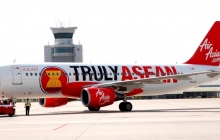AirAsia was launched in 2001 with the dream of making flying possible for everyone. Since then, AirAsia has swiftly risen to become the world’s best...
-

Logistics
Where to invest?
Logistics
As ASEAN thrives as trading and economic hub region, logistics become more complex and more vital in horizontal and vertical integration. Today, investors are presented with wide ranges of possibilities as ASEAN pursues improved connectivity through various modes and access to ports, sophisticated logistics services, and skilled professionals in all aspects of supply chains.
The world’s busiest
World Bank ranked Singapore as a No. 1 logistics hub among 139 countries globally. Singapore scored 4.3 in the Logistics Performance Indicator (LPI) 2023, which uses a 1-to-5 scale (5 as the highest) in rating countries’ logistics.1
Other ASEAN countries also performed well in the LPI, scoring more than 3 points. These include Malaysia, Thailand, Philippines, Vietnam and the Indonesia which got a score of 3.6, 3.5, 3.3, 3.3 and 3 respectively. The rest of the ASEAN countries improved their performances compared to previous years.2
Major international airports prove critical to the efficiency of logistics in the region. The Changi Airport in Singapore is the largest cargo airport in the world. It handles 2 million tonnes of cargo annually, services 6,900 weekly flights, and connects 90 cities in 60 countries.3
The Cargo Traffic 2021 Data shows the Bangkok’s and Kuala Lumpur’s international airports are as busy. Both are part of the world’s top 30 airports in terms of cargo traffic. Thailand’s Suvarnabhumi Airport handled over 1.1 million tonnes of cargo4 while the Kuala Lumpur International Airport boasts of almost 1 milliom tonnes of cargo5 in the same period.
ASEAN is among the busiest in terms of transhipment. Singapore ranked second among the top 50 container ports in the world and handled a total of 37.49 million TEUs of containers in 2021. Seven other container ports in ASEAN made it to the list of the top 50 container ports globally according to the World Shipping Council. These ports are Port Kelang and Tanjung Pelepas in Malaysia, Laem Chabang in Thailand, Tanjung Priok in Indonesia, Ho Chi Minh in Vietnam, Manila in the Philippines, Hai Phong, and Cai Mep in Vietnam.6
Towards better logistics
Realising the rise in demands for improved logistics, ASEAN member states cooperate to facilitate the movement of goods and supplies across the region. Central to this are ASEAN’s transport-related projects and trade facilitation measures such as the ASEAN Single Window.
The ASEAN Single Window connects and integrates National Single Windows of the region’s member states with the objective of accelerating cargo clearances and improving transparency in doing business. The direct exchange of the ASEAN Customs Declaration Document (ACDD) through the ASEAN Single Window (ASW) that began in December 2020 has shown rapid development. As of February 2022, six ASEAN countries, namely Cambodia, Malaysia, Myanmar, the Philippines, Singapore, and Thailand, have successfully connected to this system. Other ASEAN countries are scheduled to follow in 2022.7
Owing to the transport-intensive nature of logistics, the ASEAN prioritizes projects connecting the region. The ASEAN Highway Network (AHN) will connect capitals, sea ports, airports and other areas with high potential for investment and tourism. It consists of 23 designated routes totalling about 38,4000 kilometres. The Singapore-Kunming Rail Link, on the other hand, will pass through Singapore-Malaysia-Thailand-Cambodia-Viet Nam-China (Kunming) through railway stations and related infrastructure.
Various transport facilitation agreements have also been signed, namely: (1) ASEAN Framework Agreement on the Facilitation of Goods in Transit, (2) ASEAN Framework Agreement on Multimodal Transport, and (3) ASEAN Framework Agreement on Facilitation of Inter-State Transport. There is also commitment to fully liberalise air freight services.
-
Logistics incorporates all industry sectors and covers a wide range of activities including cargo handling, customs processing, storage, warehousing, freight, transport, logistics services, among others. ASEAN invites investors to take advantage of the wealth of opportunities in this ever-growing industry.
SUCCESS STORIES
-
- Site Map
- Terms & Abbreviations

